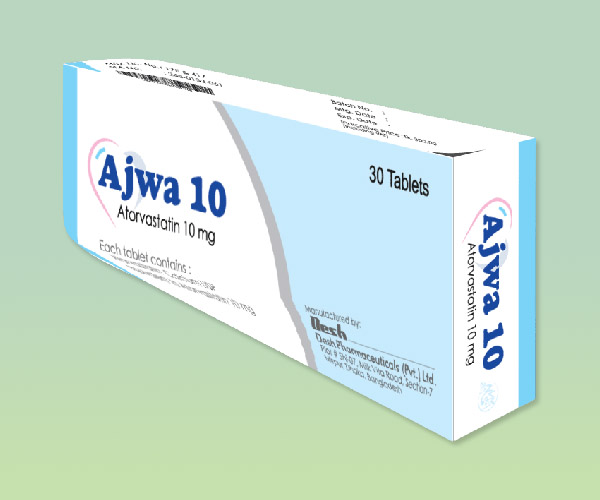Ajwa 10 Tablet
Atorvastatin
Ajwa 10 Tablet
Atorvastatin
Composition
Product name: Ajwa
Strength: Atorvastatin 10 mg as Atorvastatin Calcium Trihydrate USP
Dosage form: Tablet (film coated)
- AVAILABILITY: AVAILABLE
Pharmacology
It is a selective, competitive inhibitor of HMG-CoA reductase, the rate-limiting enzyme responsiblefor the conversion of 3- hydroxy- 3- methyl- glutaryl- coenzyme A to mevalonate, a precursor of sterols,including cholesterol. Triglycerides (TG) and cholesterol in the liver are incorporated into VLDL andreleased into the plasma for delivery to peripheral tissues. Low-density lipoprotein (LDL) is formed from VLDL and is catabolized primarily through the high affinity LDL receptor.
Atorvastatin lowers plasma cholesterol and lipoprotein levels by inhibiting HMG-CoA reductase andcholesterol synthesis in the liver and increases the number of hepatic LDL receptors on the cell surfacefor enhanced uptake and catabolism of LDL. It reduces LDL production and the number of LDL particles. It produces a profound and sustained increase in LDL receptor activity coupled with abeneficial change in the quality of circulating LDL particles.
Pharmacodynamics:
Atorvastatin as well as some of its metabolites are pharmacologically active in humans. The liver is theprimary site of action and the principal site of cholesterol synthesis and LDL clearance.
Pharmacokinetics:
Absorption: It is rapidly absorbed after oral administration; maximum plasma concentrations occur within 1 to2 hours. Extent of absorption increases in proportion of Atorvastatin dose. The absolute bioavailability ofAtorvastatin is approximately 14% and the systemic availability of HMG-CoA reductase inhibitory activity isapproximately 30%.
Distribution:Mean volume of distribution of Atorvastatin is approximately 381 L. Atorvastatin is > 98% bound to plasmaproteins.
Metabolism: It is extensively metabolized to ortho- and parahydroxylated derivatives and variousbeta-oxidation products.
Excretion: It is eliminated primarily in bile following hepatic and/or extrahepatic metabolism. However, thedrug does not appear to undergo significant enterohepatic recirculation. Mean plasma eliminationhalf-life of Atorvastatin in human is approximately 14 hours. The half-life of inhibitory activity of HMG-CoAreductase is approximately 20-30 hours due to the contribution of active metabolites.
Indications
Atorvastatin is indicated for the treatment of
- Primary hypercholesterolemia
- Heterozygous familial hypercholesterolemia
- Homozygous familial hypercholesterolemia
- Combined (mixed) hyperlipidemia
- In patients who have not responded adequately to diet and other appropriate measures.
Dose & administration
Primary hypercholesterolemia and combined hyperlipidemia, usually 10 mg once daily. Familial hypercholesterolemia, initially 10 mg daily, increased at intervals of 4 weeks to 40 mg once daily; if necessary, further increased to max. 80 mg once daily.
Route of administration: Orally.
Contra-indication
Active liver diseases or unexplained persistent elevations of serum transaminases. Hypersensitivity to any component of this medication. Pregnancy and lactation.
Warnings and precaution
Liver effects: Liver function tests should be performed before the initiation of treatment and periodically thereafter. Should an increase in ALT or AST of greater than 3 times the upper limit of normal persist, reduction of dose or withdrawal of Atorvastatin is recommended. Atorvastatin should be used with caution in patients who consume substantial quantities of alcohol and/or have a history of liver disease. Skeletal muscle effects: Uncomplicated myalgia has been reported in Atorvastatin- treated patients. Atorvastatin therapy should be discontinued if markedly elevated CPK levels occur or myopathy is diagnosed or suspected. Should significant increases in CPK persist, reduction of dose or withdrawal of Atorvastatin is recommended. Rare cases of rhabdomyolysis with acute renal failure secondary to myoglobinuria have been reported with Atorvastatin and with other drugs in this class.
Side effects
Atorvastatin is generally well tolerated. Adverse reactions have usually been mild and transient. The most frequent adverse events thought to be related to Atorvastatin were constipation, flatulence, dyspepsia and abdominal pain, headache, nausea, myalgia, diarrhea, asthenia and insomnia.
Rarely, statins may cause or worsen diabetes.
Use in pregnancy and lactation
Safety in pregnancy has not been established. HMG-CoA reductase inhibitors are not recommended for use during pregnancy. An interval of one month should be allowed from stopping atorvastatin treatment to conception in the event of planning a pregnancy.
Use of HMG-CoA reductase inhibitors during breast feeding is not recommended, because of potential for serious adverse effects in nursing infants. Geriatrics: Efficacy and safety in older patients using recommended doses is similar to that seen in general population.
Use in children & adolescents
Pediatrics: Safety and efficacy of Atorvastatin has not been established in children.
Drug interactions
The risk of myopathy during treatment with other drugs of this class is increased with concurrent administration of cyclosporine, fibric acid derivatives, niacin, erythromycin, azole antifungals.
Antacid: when atorvastatin and antacid suspension were co-administered, plasma concentration of atorvastatin decreased approximately 35% however, LDL-C reduction was not altered.
Digoxin: When multiple doses of atorvastatin and digoxin were co-administered, steady state plasma digoxin concentrations increased by approximately 20%.
Erythromycin: In healthy individuals, plasma concentration of atorvastatin increased approximately 40% with co-administration of atorvastatin and erythromycin.
Oral Contraceptives: Co-administration of atorvastatin and an oral contraceptive increased AUC values for norethindrone and ethinyl estradiol by approximately 30% and 20%.
Please note the followings:
Grapefruit juice: Do not take more than one or two small glasses of grapefruit juice per day because large quantities of grapefruit juice can change the effects of Atorvastatin.
Alcohol: Avoid drinking too much alcohol while taking this medicine.
Overdose
There is no specific treatment in the event of overdose. In the event of overdose, the patient should be treated symptomatically and supportive measures instituted as required. Liver function tests should be performed and serum CK levels should be monitored. Due to extensive atorvastatin binding to plasma proteins, hemodialysis is not expected to significantly enhance atorvastatin clearance and is unlikely to be of benefit.
Storage
Store in a cool, dry place between 15 °C to 30 °C and protect from light. Keep out of reach of children.
Packing
Ajwa 10 Tablet: Box containing 3x10/ 5x10 tablets in blister pack.
